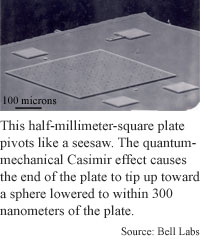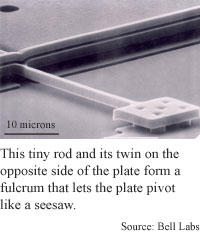
Quantum effect moves machine
By Eric Smalley, Technology Research NewsAccording to classical physics, a vacuum at a temperature of absolute zero contains no matter or energy. But according to quantum physics, this emptiness isn't really empty. It is filled with fluctuating energy.
Classical physics, as epitomized by Newton's laws, describes how matter and energy operate in the everyday world. Quantum physics describes the very different conditions that exist in the realm of atoms and subatomic particles.
A team at Lucent Technologies' Bell Labs has shown that as researchers make ever smaller machines, the quantum effect of zero point energy could come into play. The researchers built a microelectromechanical device similar to those used as tiny sensors and actuators, and measured how this energy affected it.
Zero point energy is created by subatomic particles that appear out of nothing, then rapidly disappear. Because many of the particles are photons, much of the energy is electromagnetic like light, x-rays and radio waves. "This energy pervades all space. It's everywhere," said Ho Bun Chan, a physicist at Bell Labs.
The energy becomes a factor in the world of devices when two parallel plates are positioned closely enough that the gap between them is smaller than some electromagnetic wavelengths. This means that some of the zero point energy is shut out of the gap. Because there is more zero point energy acting on the outer surfaces of the plates than the inner surfaces, the plates are drawn together.
The phenomenon, predicted in 1948 by the Dutch physicist Hendrik Casimir, observed in 1958 and measured in 1996, is called the Casimir effect. "This force arises merely because of the existence of the two plates," said Chan.
Though the force is very small at the micro scale, it increases rapidly as the distance between the plates decreases. The force between parallel plates can be as large as an atmosphere, or 14.7 pounds of pressure per square inch, at a distance of 10 nanometers, said Umar Mohideen, an associate professor of physics at the University of California at Riverside.
The Bell Labs' device consists of a 500-micron-square, 3.5-micron thick silicon plate suspended above a silicon wafer. The plate pivots, seesaw fashion, between two tiny rods. Electrodes sit on the wafer under each end of the seesaw. As the plate tilts, the capacitance on the lower side increases while that of the higher side decreases, allowing the researchers to measure very small changes in the position of the plate.
The researchers induced the Casimir effect in their device by lowering a 200-micron-diameter sphere over the plate. "When the plate is actuated by the Casimir force, the rotation is only about a thousandth of a degree. It's a tiny rotation, but it's detectable," said Chan.
The Bell Labs research "is the first step in the design and fabrication of novel MEMS devices based on the Casimir force," said Mohideen. "Finally, devices based on quantum fluctuations... are coming to fruition. This is very exciting."
The researchers used a sphere rather than a second plate because it's easier to work with even though the Casimir effect is less pronounced between a sphere and a plate, said Chan.
"We are talking about separations [of] less than a tenth of a micrometer," he said. "It's very difficult to keep two plates perfectly parallel. If you use a sphere there's only one point where it's closest to the plate. It basically gets rid of the alignment problem," he said.
The plate tilted due to the Casimir effect when the sphere was 300 nanometers above one end of the plate. The tilt increased sharply as the researchers moved the sphere closer to the plate.
"We can speculate [about] making very sensitive position sensors, for example, because this force rises very quickly with distance," said Chan.
As Bell Labs' use of a sphere illustrates, the effect is not limited to parallel plates.
"The Casimir force is strongly shape dependent and can be repulsive as well as attractive," said Mohideen. "It can be further modified with subtle texturing on the surfaces, like putting in corrugations. Incorporating the shape-dependent Casimir force should give an additional knob for engineers to turn in future MEMS designs," he said.
A NASA-funded project is even exploring how to use the Casimir effect in a propulsion system for spacecraft.
The Casimir effect is already a problem for fabricating MEMS devices because at very short distances free surfaces tend to stick together, said Mohideen. "During the fabrication step, it is very hard to make free moving surfaces such as cantilevers [and] bridges which are separated by short distances," he said.
It's difficult to predict how the Casimir effect will be used in microelectromechanical systems, said Chan. "Our work is trying to demonstrate that if the device sizes continue to shrink then we might have to take into account quantum effects," he said.
The Casimir effect could be a factor for MEMS designers in five years, he said.
Chan's research colleagues were Vladimir A. Aksyuk, Raphael N. Kleiman, David J. Bishop and Federico Capasso of Bell Labs. They published the research in the February 8, 2001 issue of Science's Sciencexpress. The research was funded by Lucent Technologies.
Timeline: 5 years
Funding: Corporate
TRN Categories: Microelectromechanical Systems; Physics
Story Type: News
Related Elements: Technical paper, "Quantum Mechanical Actuation of Microelectromechanical Systems by the Casimir Force," Sciencexpress, February 8, 2001
Advertisements:
February 14, 2001
Page One
Quantum effect moves machine
Software speeds gene comparison
Agents learn from traveling salesman
Harder chips make more sensitive sensors
Silver atoms shine red and green


News:
Research News Roundup
Research Watch blog
Features:
View from the High Ground Q&A
How It Works
RSS Feeds:
News
Ad links:
Buy an ad link
| Advertisements:
|
 |
Ad links: Clear History
Buy an ad link
|
TRN
Newswire and Headline Feeds for Web sites
|
© Copyright Technology Research News, LLC 2000-2006. All rights reserved.